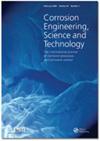Vibratory polishing effects on passivity of 304L stainless steel surfaces
IF 1.5
4区 材料科学
Q4 MATERIALS SCIENCE, MULTIDISCIPLINARY
Corrosion Engineering, Science and Technology
Pub Date : 2023-10-05
DOI:10.1080/1478422x.2023.2264655
引用次数: 0
Abstract
ABSTRACTSurface spectroscopy analysis and electrochemistry were applied to study the effects of surface preparation by vibratory polishing on the passivity of stainless steel 304L surfaces. Compared to grinding by traditional mechanical polishing, vibratory polishing promotes the enrichment of Cr(III) oxide and hydroxide species in the duplex chemical structure of the surface native oxide film by enhancing selective Fe oxidation and dissolution. As a result, spontaneous passivity, tested in aggressive sulphuric acid electrolyte, is enhanced. However, in the absence of enrichment in Mo(IV) and Mo(VI) species in the passive film, the Cr enrichment does not enhance passivity upon anodic polarisation nor increase the resistance to Cl-induced passivity breakdown and initiation of localised corrosion in accelerated testing conditions. The results provide comprehensive insight into the mechanisms underlying the passivity enhancement of stainless steel by surface engineering.KEYWORDS: Surface treatmentvibratory polishingstainless steeloxide filmpassivitylocalised corrosion Disclosure statementNo potential conflict of interest was reported by the author(s).Additional informationFundingThis project has received funding from the European Research Council (ERC) under the European Union’s Horizon 2020 research and innovation program (ERC Advanced grant number 741123).振动抛光对304L不锈钢表面钝化的影响
摘要采用表面光谱学和电化学方法研究了振动抛光表面处理对304L不锈钢表面钝化性能的影响。与传统机械抛光相比,振动抛光通过增强Fe的选择性氧化和溶解,促进了表面天然氧化膜双相化学结构中Cr(III)氧化物和氢氧化物的富集。因此,在腐蚀性硫酸电解质中测试的自发钝化性得到了增强。然而,在钝化膜中没有富集Mo(IV)和Mo(VI)的情况下,Cr的富集不会增强阳极极化后的钝化性,也不会增加加速测试条件下对cl诱导的钝化击穿和局部腐蚀的抵抗能力。研究结果为通过表面工程提高不锈钢钝化性能的机理提供了全面的见解。关键词:表面处理振动抛光不锈钢氧化膜钝化局部腐蚀披露声明作者未报告潜在利益冲突。本项目已获得欧洲研究委员会(ERC)在欧盟地平线2020研究和创新计划(ERC高级资助号741123)下的资助。
本文章由计算机程序翻译,如有差异,请以英文原文为准。
求助全文
约1分钟内获得全文
求助全文
来源期刊

Corrosion Engineering, Science and Technology
工程技术-材料科学:综合
CiteScore
3.20
自引率
5.60%
发文量
58
审稿时长
3.4 months
期刊介绍:
Corrosion Engineering, Science and Technology provides broad international coverage of research and practice in corrosion processes and corrosion control. Peer-reviewed contributions address all aspects of corrosion engineering and corrosion science; there is strong emphasis on effective design and materials selection to combat corrosion and the journal carries failure case studies to further knowledge in these areas.
 求助内容:
求助内容: 应助结果提醒方式:
应助结果提醒方式:


